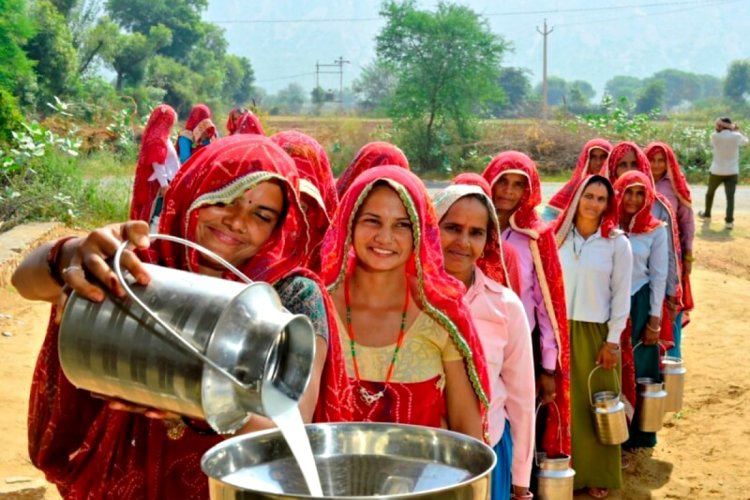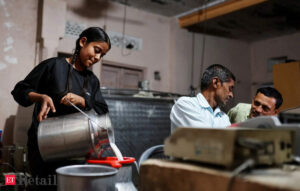
From being a milk-deficient country 50 years ago to becoming the world’s largest milk producer, India has witnessed an extraordinary journey. Today, milk is not only the top agricultural product in the country but also a vital component of its economy.
India’s dairy sector, with its 8 crore dairy farmers, stands as a shining testament to the transformative power of collective effort and strategic growth. From being a milk-deficient country 50 years ago to becoming the world’s largest milk producer, India has witnessed an extraordinary journey. Today, milk is not only the top agricultural product in the country but also a vital component of its economy. The Indian dairy industry, valued at ₹14 lakh crore, contributes 5% to the GDP and almost one-third of the agricultural sector, underscoring its importance in the national economic framework.
A Critical Pillar of Rural Economies: In the face of a rapidly evolving agricultural landscape, the dairy sector has emerged as a critical pillar of rural economies. Unlike seasonal crops, dairy farming provides a consistent and reliable source of income throughout the year, helping farmers stabilize their income and reduce their reliance on loans and external financial aid. This stability is particularly crucial in rural areas, where agricultural income can be unpredictable due to factors such as climate change, market volatility, and crop failures.
Over the past five decades, while India’s population has grown by 2.5 times, milk production has increased tenfold, far outpacing the growth of other staples like cereals, which have only increased by 2.8 times. This remarkable growth in milk production has been instrumental in transforming the lives of millions of landless and marginal farmers, offering them a sustainable livelihood and lifting them out of poverty.
The labor-intensive nature of dairy farming also generates substantial employment opportunities in rural areas. From animal husbandry to milk processing and distribution, the dairy sector provides jobs for millions, contributing significantly to rural economies and helping to alleviate poverty.
Empowering Women Economically: Women constitute 48.5% of India’s population, and their contribution to the national economy is steadily increasing. In the agricultural sector, farm women are the backbone, carrying out more than 70% of activities in dairy farming. Their involvement in this sector is crucial not only for food and nutritional security but also for the economic stability of rural households.
In many rural communities, women are primarily responsible for the care of livestock, yet their contributions often go unrecognized and undervalued. By formalizing their roles and providing them with ownership and control over dairy-related assets, the dairy sector empowers women to become direct stakeholders in the business. This empowerment enhances their financial independence and decision-making power within the household, leading to improved socio-economic status and greater self-confidence.
Moreover, the dairy sector plays a vital role in promoting gender equality in rural areas. As more women become active participants in the economy through dairy farming, they gain the confidence to advocate for their rights and take on leadership roles within their communities. This shift not only fosters a more inclusive and equitable society but also drives community development efforts, further contributing to rural prosperity.
Challenges for the Indian Dairy Industry: The dairy industry is currently navigating several significant challenges. One of the primary concerns is the varying interpretations of sustainability among farmers, consumers, and policymakers. The key issue here is how to maintain a balanced, win-win situation for both farmers and consumers, ensuring that the growth in milk production benefits all stakeholders.
Another critical challenge is staying competitive in the international market. We cannot rely on simply increasing milk prices to boost production. Instead, we must focus on enhancing animal productivity and reducing the cost of milk production. To increase exports, our dairy products need to be competitively priced and meet international quality standards. Therefore, a central question is how to lower the cost per liter of milk production. This can only be achieved through better feed conversion rates and improved breeding practices.
Additionally, there is the challenge of reconciling food inflation with food prosperity. Often, when farmers receive better remuneration for their produce, it is labelled as food inflation. However, this should be seen as prosperity and an incentive for farmers to continue producing milk. We need to address the delicate balance between food security and the livelihood of farmers.
The industry also faces a challenge in securing adequate budget allocations that reflect dairy’s contribution to agriculture, which has not kept pace with the sector’s growth over the years. Making milk production a thriving and modern business is essential to ensure that future generations remain engaged in the industry.
Another pressing issue is the spread of misinformation by proponents of alternative non-milk beverages. We must counter this by raising consumer awareness about the benefits of milk. Additionally, there is a growing focus on sustainability and environmental concerns in dairy production. For small and marginal farmers in India, the priority should be on emissions linked to livelihood rather than luxury, balancing the need for sustainability with the reality of their economic dependence on dairy farming.
Conclusion: The potential of the dairy sector in India is immense, both as a means of improving farming incomes and as a powerful tool for the economic empowerment of women. By continuing to invest in and support this sector, India can ensure sustained economic growth, enhanced rural livelihoods, and a more equitable society. The dairy industry, with its proven track record of success, holds the promise of a brighter future for millions of farmers and women across the country.
(The writer is President of Indian Dairy Association, former Managing Director, Amul (GCMMF))



